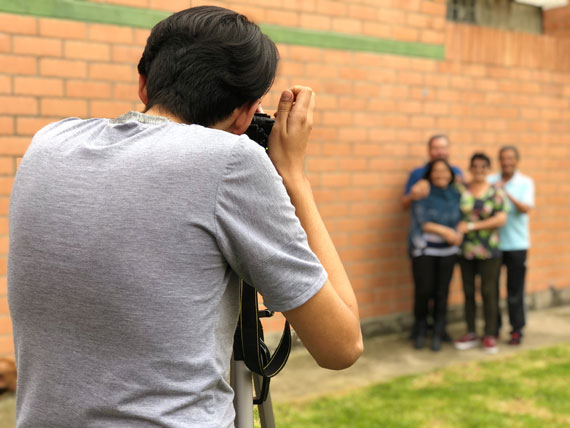Pricing… you can’t work as a professional photographer for long without getting caught up in the subject of pricing your work (well, you could, perhaps, but you would never make any money). Then there’s the question of not only what prices to charge, but also how to educate your clients about your price list without them bailing out or thinking you’re trying to pressure them.

Photo by Pedro de Sousa; ISO 200, f/9.0, 1/1250s, 140mm.
In the time that I’ve been running my studio as a professional photographer, I’ve explored different methods of presenting my prices to clients and potential clients, with various degrees of success. These include the usual suspects:
- Printed price menus
- Combined price list and brochure
- Website price page
- Sending out price lists by email
But, the issue I had with these methods was that sales just didn’t seem to be where I wanted them to be. I would hand out price lists to prospects who requested them, count the accesses to my price list page, or email my list to anyone who asked for it; yet the clients disappeared as quickly as they came, like ghosts. This was a complete puzzle to me, and it didn’t take too much of that to imagine that my prices must be too high.
Looking at my price list, and considering the lack of returning customers, I really did start to think that my prices were too high, so I made the awful mistake of lowering them. Yes, you guessed it; I got just the same result. The moral is that we can get tangled up in a vicious cycle of always fiddling with the fees.
Is any of this familiar? Are you stuck in that wasteland of trying to second-guess your prospects to find out what you think they would easily pay, rather than what you believe they should pay?
You aren’t alone. Just about every professional photographer I know has encountered this painful process. But, there is a solution…
Show, Don’t Tell
The answer to this problem really requires three distinct things.
- Decide what your products and services are going to be (i.e. what it is that you’re actually selling).
- Decide on your fees, based on your production costs, level of competition and income requirements.
- Produce one price list that is yours, and yours alone.
That’s correct, just ONE. No one sees your complete price list unless you personally give it to them, complete with a full sales presentation and in-depth explanation of everything you offer.
I can hear you exclaiming, “that’s the dumbest thing I’ve heard!” but stick with me here for just a moment.
There is a perfectly good explanation for why the other methods don’t work effectively. When a customer looks at a website and finds a price list, they can see how much a portrait or a wedding package costs. But how are they going to compare that with what they’ve seen elsewhere, except by the price?

Photo by Gerson Crespo
All of a sudden, your prospect has been turned into a price comparison shopper! In the mind of most clients, all 8x10s are printed equal, but we know that couldn’t be more wrong. It’s what is printed on the paper that’s critical, not the print itself. But how can we clarify this to the prospect when they’re sitting at home reading a price list?
Wedding photography packages are an even better example. Displaying a price for a collection on a website or in a pamphlet they can take home is only going to make the prospect think, “I get such and such for this price, but that other photographer down the street will give me the same or more for a lower price.” You and I both know that the “other” photographer won’t put as much time into the wedding day as you will, doesn’t have the level of experience you do, won’t deliver as fast, or simply isn’t as professional. But the prospect is only looking at prices.
The same thing goes when the prospect calls you on the phone. The first question is, “how much?” If you answer that question straight away, they’re gone, and we never hear from them after that. Instead, we have to divert our chat away from the price (at least at the beginning of the call) and on to the less logical reasons for the photography they’re looking for. Once we’ve had a chance to educate them about what makes us unique, then we can gently mention pricing, after which we arrange to meet with them personally for a more detailed consultation if the price is within their expectations.
By the time the prospect meets with you for a consultation, they already understand that your prices are affordable.
The Personal Touch
As you might expect, I meet with every prospect before I allow them to book a portrait session or a wedding. This is an opportunity to give my complete sales presentation before showing them my price list. As a salesperson, it is my job to ensure I understand as much about their wants as possible before selling them anything—they won’t care what I know until they know I care about them. If making money is the only motivator for you as a professional photographer, then you’re in the wrong business.
There is one copy of my price list, and I keep it in a leather binder, printed on fine paper. To the prospect, it looks like an official copy, which it is, and nobody has ever asked to take it home.
When I’m meeting with a customer to discuss a wedding or portrait session, it can take 45 minutes to an hour before we ever get to the topic of price. The price list is there in front of them, I’m sure they know what it is, but I don’t open it until I’m ready. If they ask about the price list, and I don’t feel ready for them to see it, I simply say, “I’m so happy you brought that up, and I’ll be glad to go over it shortly. But first…” and then I ask them more questions about the wedding or portrait.
By the time we do get to the price list, we’ve talked about the wedding day, how the couple met, what they like to do together, what’s important to them and their family about the wedding, how many bridesmaids and groomsmen they have, the color scheme, etc. At that point, they understand that I really care about them, and now the topic of price is no longer the main driving force. Obviously, they will have a plan in mind, and there should be a collection that falls within that range, but they are no longer just comparing our prices to everyone else’s. They are making a comparison, but it’s a comparison of things like service, quality, attention to detail, personality, etc.
Selling: Start At The Top!
When I go through the price list, I start with the most expensive choice, even if they’ve already indicated their budget. Doing it like this, I only have to sell down and not up. Selling up is as hard as climbing a mountain—it’s usually much simpler going down than up.
Don’t make the awful mistake of confusing this method for pressure sales, because it isn’t. The reason for selling down is to help them become involved with a package that’s appropriate for them, even if it does happen to be the cheapest one you offer.
The client doesn’t understand as much about creative professional photography as we do, so they may not truly understand which considerations they ought to be most concerned about. Instead, they get stuck on the only thing they can relate to, which happens to be the price. At the end of the day, it’s our job to get them off the price and re-connect them with the real elements of what we do.

Photo by Szabo Viktor; ISO 100, f/1.8, 1/50s, 35mm.
Summary
I just want to make sure that I underline this point:
I have only one printed price list to show to prospective clients.
There are no prices listed on my website, no prices emailed out to those who ask for them, no detailed prices given over the telephone, and no brochure with a few photographs and my prices for them to take away.
I’m not hiding anything from my customers or trying to deceive them—that’s not the way to run a solid photography business. But, it does demonstrate to my prospects that I value them above the prices for my photography. It also helps to screen out the types of prospects I don’t want to work with—the ones to whom price is the main important factor and to whom family, relationships, memories, and emotions are not as valued.
So far, no one has complained about this procedure. My customers now treat my prices with respect, and they understand the context in which they’re given. This encourages better sales and, in my opinion, an overall better experience for the prospect.
About the Author:
Nigel Merrick is a professional photographer, blogger and business coach for other working photographers. Nigel’s blog helps professional photographers find peace in their business, love from their clients, and happiness in their personal lives by clarifying their focus on business and marketing.
Like This Article?
Don't Miss The Next One!
Join over 100,000 photographers of all experience levels who receive our free photography tips and articles to stay current:






Great article, I have recently placed a “prices from” on my website which usually get’s rid of the bargain hunters. I totally agree with the philosophy of meeting with the client and showing them that you are not a commodity. Still puzzled how to deflect the ‘how much are you’ emails, I think that type of client are just chancers anyway.
Great…..!!!
Thank you Nigel, for leaving us such a great article.
We all need an article like this, we are not a commodity, we’re selling the value of the memories csptured and how well we do that. If a hard drive crashed or house catches fire and all the family is safe, what’s the first thing on the person’s mind to save? It’s not Excel files or a $400 pair of shoes, I can tell you that!.
if a price has to get revealed, I do like the way Jasmine Star does it. All her website says is, “Packages starting at $7500.” When people contact her, they already know what value she brings to the table, and the “I want a $1200 photographer” crowd is immediately diverted. Just a thought.
Very revealing. I’ve been tearing my hair out on this – I’d always thought it was best to be open and up front about prices on my website, but after reading this, I can see that it’s actually what’s been putting people off! It’s frustrating, but I guess it’s time to make some changes. I nearly always get asked in the first contact about prices, and, as you point out, many of them quickly disappear. I suppose if someone does email asking about prices, should I respond along the lines of “I would need to sit down with you and discuss the shoot before I can give you a price”? What would you do?
Thanks again for sharing this article, I appreciate it and am honored that you found it valuable enough to post here. I definitely agree with @Bruce’s additional comments above, and it’s worth underlining the idea that we are selling trust and professionalism first, and photography second. One excellent way of generating trust, which many photographers fail to utilize very well, is to recommend prospects to someone who may be a better fit for their current project if pricing is a real barrier for them. Not only will they appreciate the genuine desire to help, they are far more likely to remember you the next they need a photographer, and they may have the budget next time around.
Wishing all professional photographers everywhere a very Happy New Year!
Nigel,
You make many good points here and it does take time to find what works best for you business. Your compensation is based on the value you deliver to your clients. That includes the investment they will make to have your photography products.
Also, perhaps more importantly is the experience of dealing with you, your professionalism, your personality and how your unique photography will benefit them. Build trust and like-ability in your relationships with your potential clients.
Focus on the benefits to them and don’t get into price comparisons with other photographers. Listing prices focuses their attention on money and photography is an emotional product.
Great article!
I just started as a wedding photographer this year.
This article helps me a lot.
Thank you ^_^